airbag Hyundai Accent 2011 Owner's Manual
[x] Cancel search | Manufacturer: HYUNDAI, Model Year: 2011, Model line: Accent, Model: Hyundai Accent 2011Pages: 282, PDF Size: 14.82 MB
Page 9 of 282
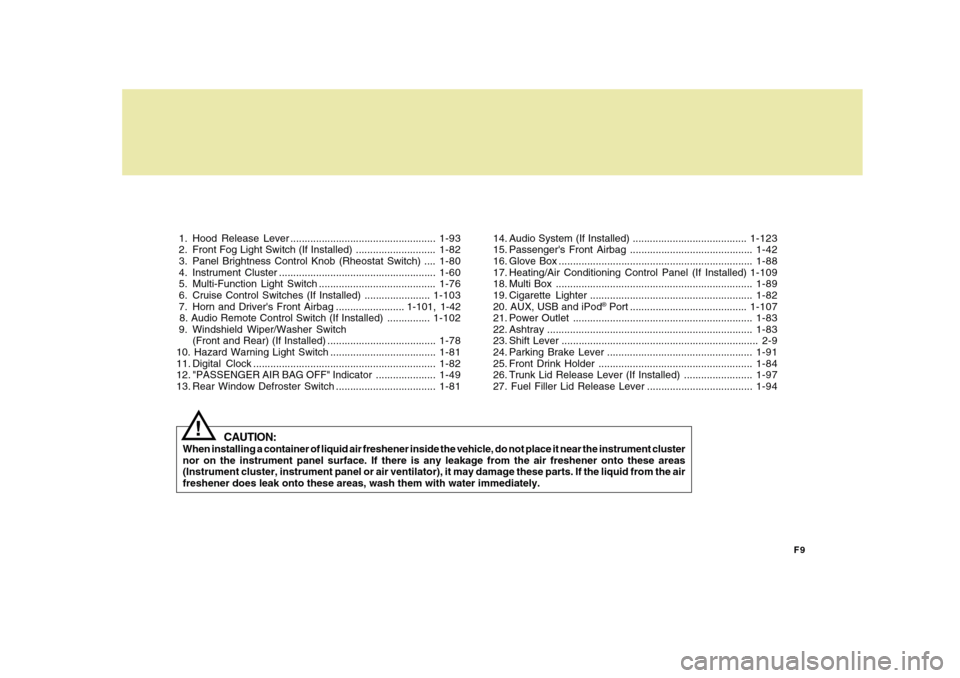
F9
1. Hood Release Lever ...................................................1-93
2. Front Fog Light Switch (If Installed) ............................1-82
3. Panel Brightness Control Knob (Rheostat Switch) ....1-80
4. Instrument Cluster .......................................................1-60
5. Multi-Function Light Switch .........................................1-76
6. Cruise Control Switches (If Installed) .......................1-103
7. Horn and Driver's Front Airbag ........................ 1-101, 1-42
8. Audio Remote Control Switch (If Installed) ...............1-102
9. Windshield Wiper/Washer Switch
(Front and Rear) (If Installed) ......................................1-78
10. Hazard Warning Light Switch .....................................1-81
11. Digital Clock ................................................................1-82
12. "PASSENGER AIR BAG OFF" Indicator .....................1-49
13. Rear Window Defroster Switch ...................................1-8114. Audio System (If Installed) ........................................1-123
15. Passenger's Front Airbag ...........................................1-42
16. Glove Box ....................................................................1-88
17. Heating/Air Conditioning Control Panel (If Installed)1-109
18. Multi Box .....................................................................1-89
19. Cigarette Lighter .........................................................1-82
20. AUX, USB and iPod
® Port .........................................1-107
21. Power Outlet ...............................................................1-83
22. Ashtray........................................................................1-83
23. Shift Lever ..................................................................... 2-9
24. Parking Brake Lever ...................................................1-91
25. Front Drink Holder ......................................................1-84
26. Trunk Lid Release Lever (If Installed) ........................1-97
27. Fuel Filler Lid Release Lever .....................................1-94
CAUTION:
When installing a container of liquid air freshener inside the vehicle, do not place it near the instrument cluster
nor on the instrument panel surface. If there is any leakage from the air freshener onto these areas
(Instrument cluster, instrument panel or air ventilator), it may damage these parts. If the liquid from the air
freshener does leak onto these areas, wash them with water immediately.
!
Page 10 of 282
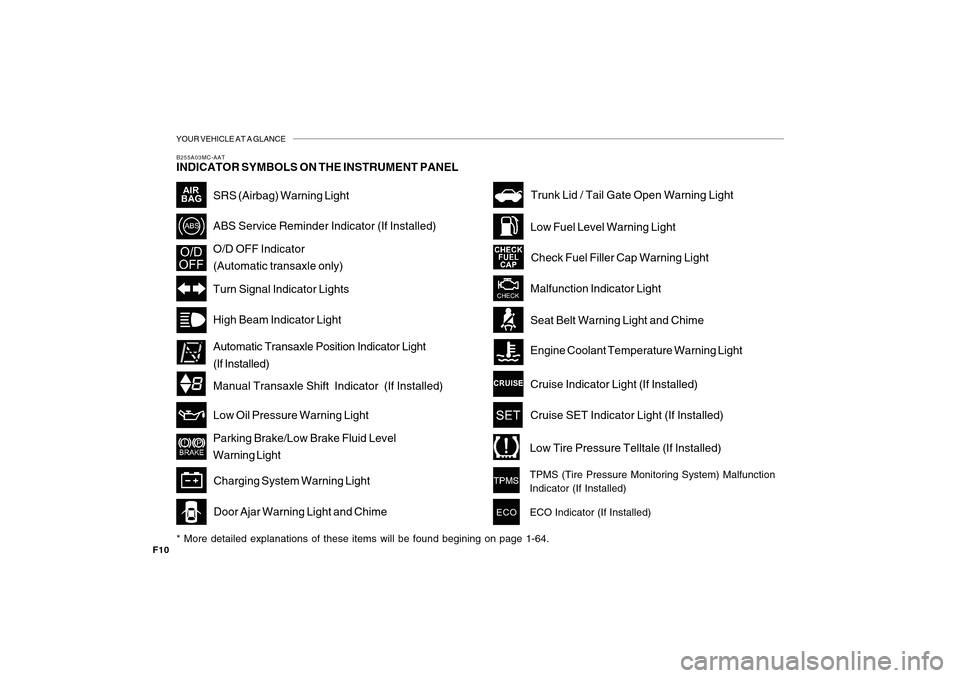
YOUR VEHICLE AT A GLANCE
F10
B255A03MC-AATINDICATOR SYMBOLS ON THE INSTRUMENT PANEL* More detailed explanations of these items will be found begining on page 1-64.
SRS (Airbag) Warning LightHigh Beam Indicator LightLow Oil Pressure Warning LightParking Brake/Low Brake Fluid Level
Warning LightCharging System Warning Light
Door Ajar Warning Light and Chime
Trunk Lid / Tail Gate Open Warning LightLow Fuel Level Warning Light
Check Fuel Filler Cap Warning LightMalfunction Indicator LightSeat Belt Warning Light and ChimeEngine Coolant Temperature Warning LightCruise Indicator Light (If Installed)Cruise SET Indicator Light (If Installed)Low Tire Pressure Telltale (If Installed)TPMS (Tire Pressure Monitoring System) Malfunction
Indicator (If Installed)
ECO
ECO Indicator (If Installed)
ABS Service Reminder Indicator (If Installed)O/D OFF Indicator
(Automatic transaxle only)Turn Signal Indicator Lights
Manual Transaxle Shift Indicator (If Installed) Automatic Transaxle Position Indicator Light
(If Installed)
Page 12 of 282
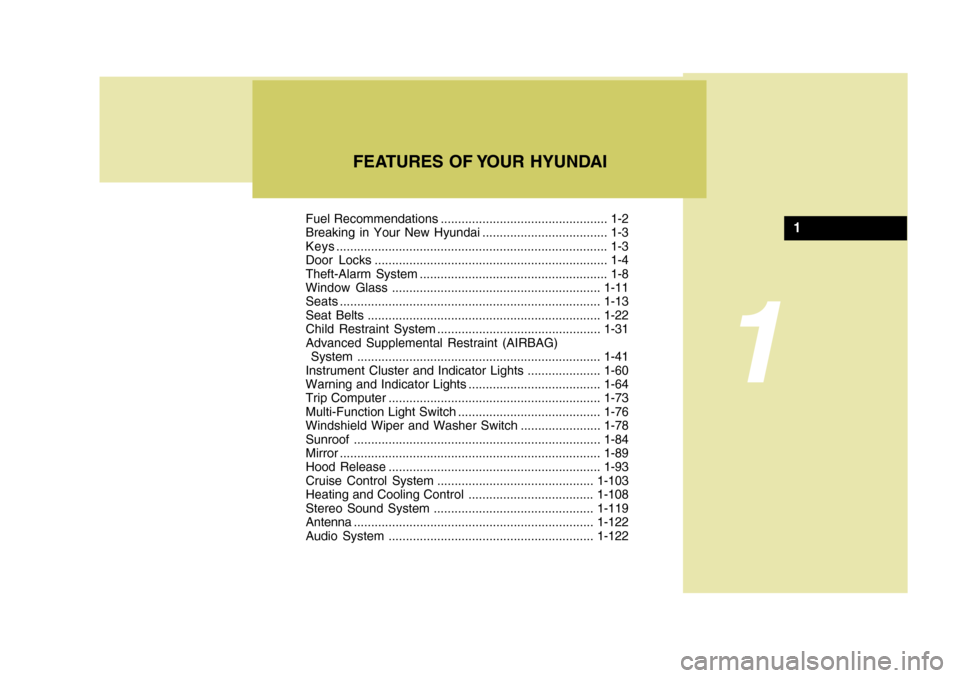
FEATURES OF YOUR HYUNDAI
1
Fuel Recommendations ................................................ 1-2
Breaking in Your New Hyundai .................................... 1-3
Keys.............................................................................. 1-3
Door Locks ................................................................... 1-4
Theft-Alarm System ...................................................... 1-8
Window Glass ............................................................1-11
Seats...........................................................................1-13
Seat Belts...................................................................1-22
Child Restraint System...............................................1-31
Advanced Supplemental Restraint (AIRBAG)
System......................................................................1-41
Instrument Cluster and Indicator Lights .....................1-60
Warning and Indicator Lights ......................................1-64
Trip Computer.............................................................1-73
Multi-Function Light Switch .........................................1-76
Windshield Wiper and Washer Switch.......................1-78
Sunroof.......................................................................1-84
Mirror...........................................................................1-89
Hood Release.............................................................1-93
Cruise Control System.............................................1-103
Heating and Cooling Control.................................... 1-108
Stereo Sound System..............................................1-119
Antenna.....................................................................1-122
Audio System...........................................................1-122
1
Page 25 of 282
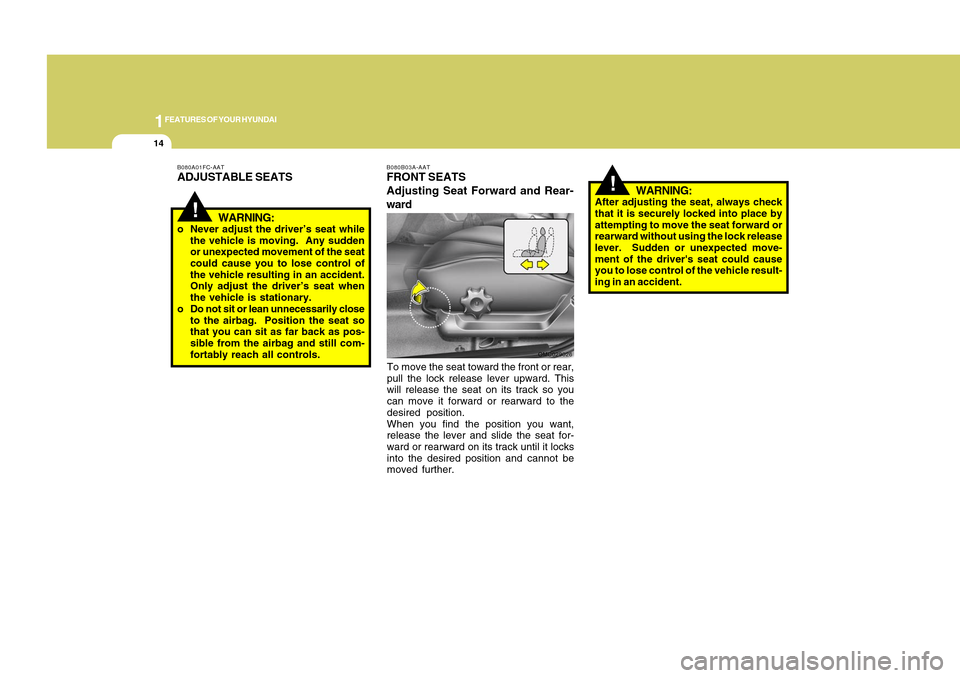
1FEATURES OF YOUR HYUNDAI14
To move the seat toward the front or rear,
pull the lock release lever upward. This
will release the seat on its track so you
can move it forward or rearward to the
desired position.
When you find the position you want,
release the lever and slide the seat for-
ward or rearward on its track until it locks
into the desired position and cannot be
moved further.
!
WARNING:
After adjusting the seat, always check
that it is securely locked into place by
attempting to move the seat forward or
rearward without using the lock release
lever. Sudden or unexpected move-
ment of the driver's seat could cause
you to lose control of the vehicle result-
ing in an accident.
B080B03A-AATFRONT SEATS
Adjusting Seat Forward and Rear-
ward
!
WARNING:
o Never adjust the driver’s seat while
the vehicle is moving. Any sudden
or unexpected movement of the seat
could cause you to lose control of
the vehicle resulting in an accident.
Only adjust the driver’s seat when
the vehicle is stationary.
o Do not sit or lean unnecessarily close
to the airbag. Position the seat so
that you can sit as far back as pos-
sible from the airbag and still com-
fortably reach all controls.B080A01FC-AATADJUSTABLE SEATS
OMC029026
Page 26 of 282
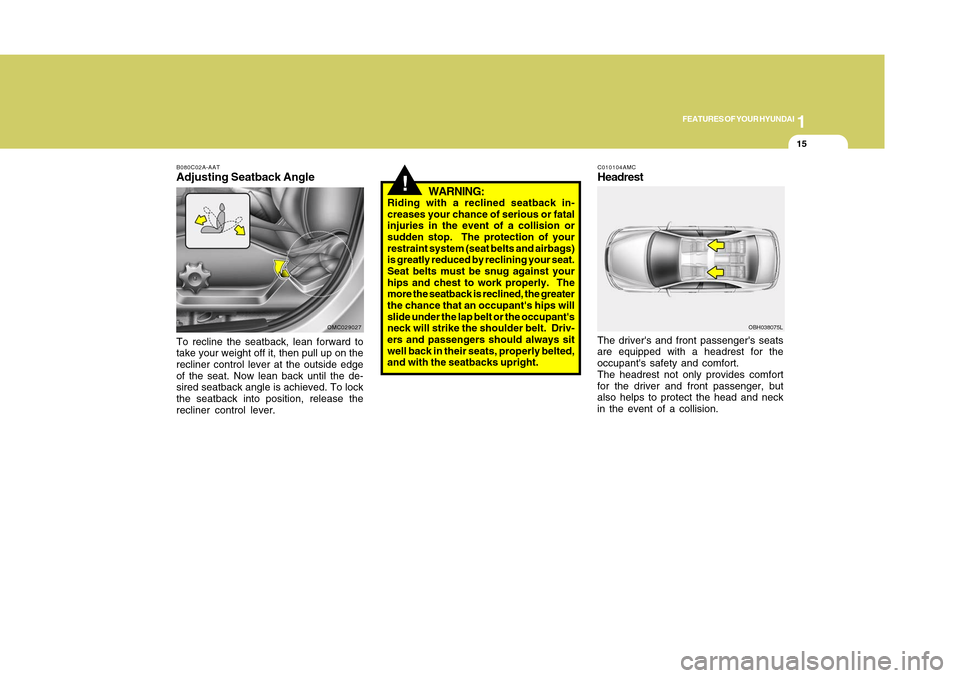
1
FEATURES OF YOUR HYUNDAI
151
FEATURES OF YOUR HYUNDAI
15
B080C02A-AATAdjusting Seatback AngleTo recline the seatback, lean forward to
take your weight off it, then pull up on the
recliner control lever at the outside edge
of the seat. Now lean back until the de-
sired seatback angle is achieved. To lock
the seatback into position, release the
recliner control lever.
!
WARNING:
Riding with a reclined seatback in-
creases your chance of serious or fatal
injuries in the event of a collision or
sudden stop. The protection of your
restraint system (seat belts and airbags)
is greatly reduced by reclining your seat.
Seat belts must be snug against your
hips and chest to work properly. The
more the seatback is reclined, the greater
the chance that an occupant's hips will
slide under the lap belt or the occupant's
neck will strike the shoulder belt. Driv-
ers and passengers should always sit
well back in their seats, properly belted,
and with the seatbacks upright.
OMC029027
C010104AMCHeadrestThe driver's and front passenger's seats
are equipped with a headrest for the
occupant's safety and comfort.
The headrest not only provides comfort
for the driver and front passenger, but
also helps to protect the head and neck
in the event of a collision.
OBH038075L
Page 33 of 282
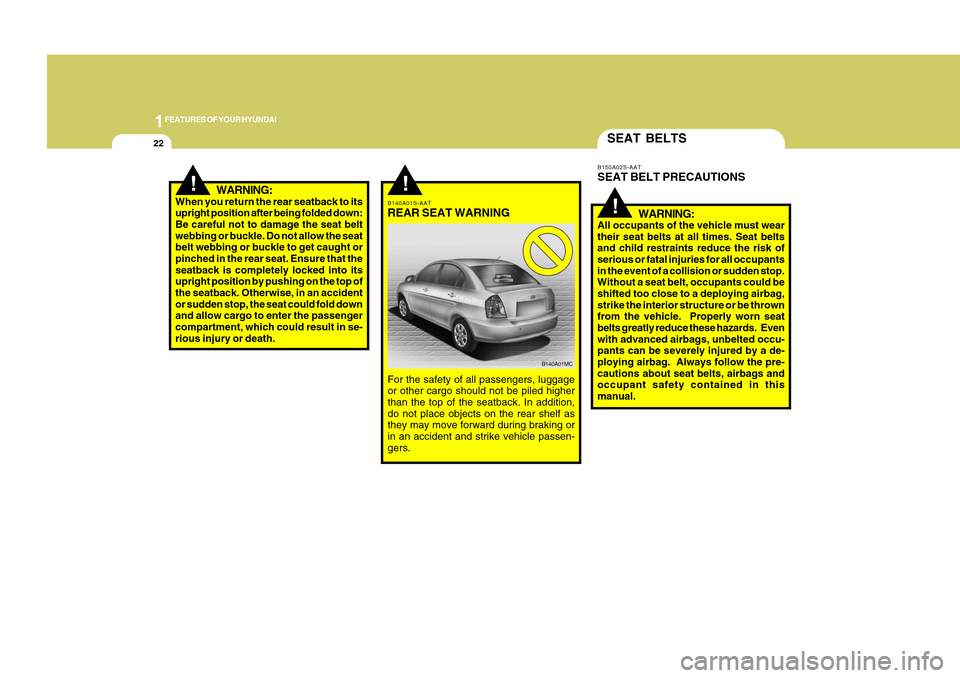
1FEATURES OF YOUR HYUNDAI22
SEAT BELTS
B140A01S-AATREAR SEAT WARNINGFor the safety of all passengers, luggage
or other cargo should not be piled higher
than the top of the seatback. In addition,
do not place objects on the rear shelf as
they may move forward during braking or
in an accident and strike vehicle passen-
gers.
B140A01MC
!
!
B150A02S-AATSEAT BELT PRECAUTIONS
WARNING:All occupants of the vehicle must wear
their seat belts at all times. Seat belts
and child restraints reduce the risk of
serious or fatal injuries for all occupants
in the event of a collision or sudden stop.
Without a seat belt, occupants could be
shifted too close to a deploying airbag,
strike the interior structure or be thrown
from the vehicle. Properly worn seat
belts greatly reduce these hazards. Even
with advanced airbags, unbelted occu-
pants can be severely injured by a de-
ploying airbag. Always follow the pre-
cautions about seat belts, airbags and
occupant safety contained in this
manual.
!
WARNING:
When you return the rear seatback to its
upright position after being folded down:
Be careful not to damage the seat belt
webbing or buckle. Do not allow the seat
belt webbing or buckle to get caught or
pinched in the rear seat. Ensure that the
seatback is completely locked into its
upright position by pushing on the top of
the seatback. Otherwise, in an accident
or sudden stop, the seat could fold down
and allow cargo to enter the passenger
compartment, which could result in se-
rious injury or death.
Page 35 of 282
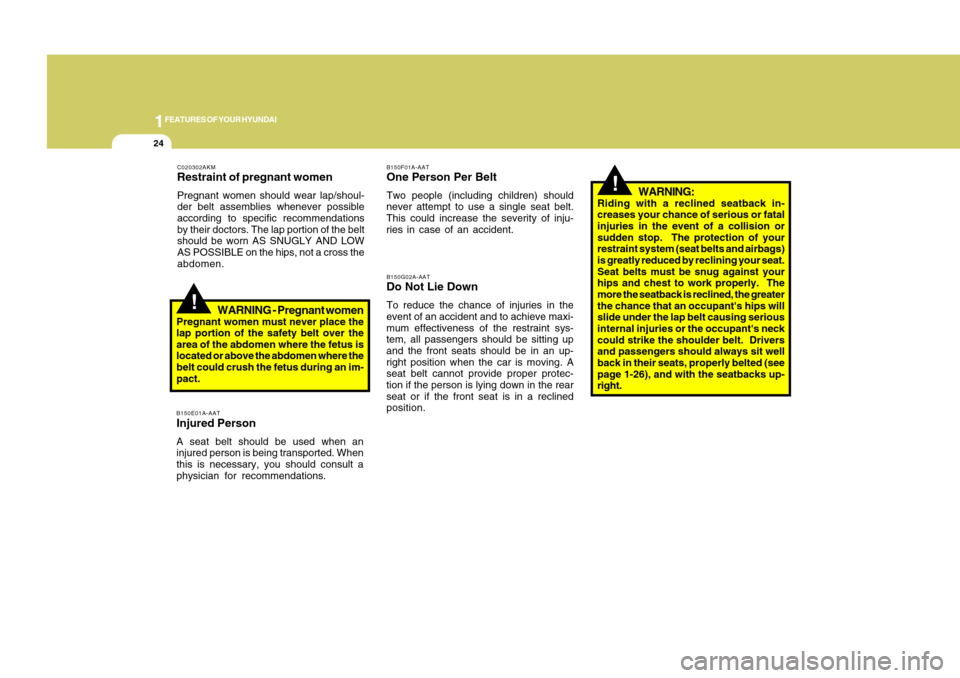
1FEATURES OF YOUR HYUNDAI24
!
B150F01A-AATOne Person Per BeltTwo people (including children) should
never attempt to use a single seat belt.
This could increase the severity of inju-
ries in case of an accident.B150G02A-AATDo Not Lie DownTo reduce the chance of injuries in the
event of an accident and to achieve maxi-
mum effectiveness of the restraint sys-
tem, all passengers should be sitting up
and the front seats should be in an up-
right position when the car is moving. A
seat belt cannot provide proper protec-
tion if the person is lying down in the rear
seat or if the front seat is in a reclined
position.
WARNING:
Riding with a reclined seatback in-
creases your chance of serious or fatal
injuries in the event of a collision or
sudden stop. The protection of your
restraint system (seat belts and airbags)
is greatly reduced by reclining your seat.
Seat belts must be snug against your
hips and chest to work properly. The
more the seatback is reclined, the greater
the chance that an occupant's hips will
slide under the lap belt causing serious
internal injuries or the occupant's neck
could strike the shoulder belt. Drivers
and passengers should always sit well
back in their seats, properly belted (see
page 1-26), and with the seatbacks up-
right.
B150E01A-AATInjured PersonA seat belt should be used when an
injured person is being transported. When
this is necessary, you should consult a
physician for recommendations.C020302AKMRestraint of pregnant womenPregnant women should wear lap/shoul-
der belt assemblies whenever possible
according to specific recommendations
by their doctors. The lap portion of the belt
should be worn AS SNUGLY AND LOW
AS POSSIBLE on the hips, not a cross the
abdomen.
!
WARNING - Pregnant women
Pregnant women must never place the
lap portion of the safety belt over the
area of the abdomen where the fetus is
located or above the abdomen where the
belt could crush the fetus during an im-
pact.
Page 43 of 282
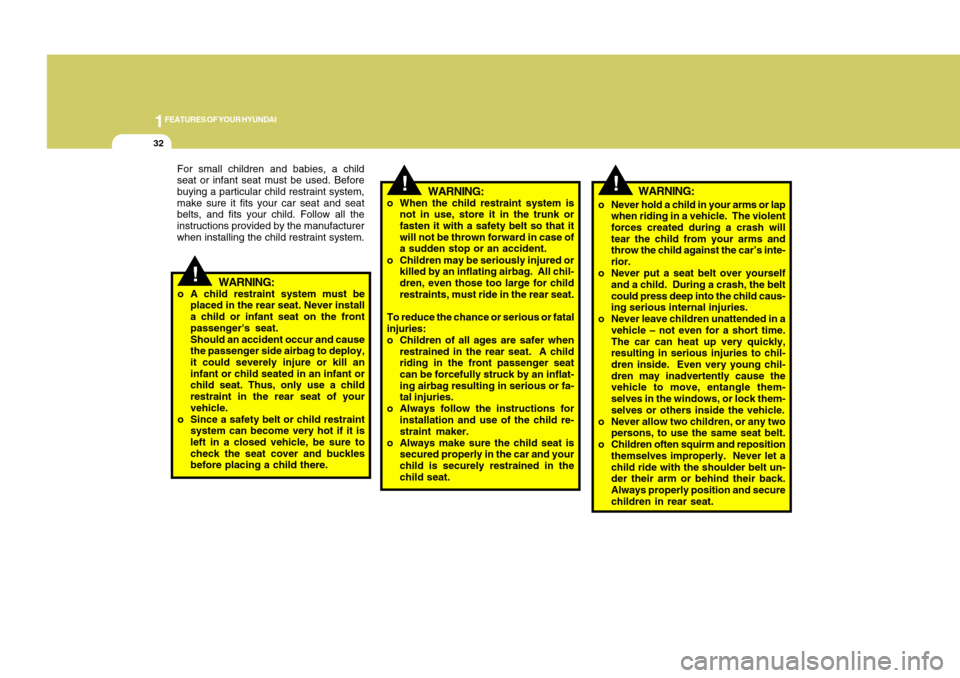
1FEATURES OF YOUR HYUNDAI32
!
o Never hold a child in your arms or lap
when riding in a vehicle. The violent
forces created during a crash will
tear the child from your arms and
throw the child against the car’s inte-
rior.
o Never put a seat belt over yourself
and a child. During a crash, the belt
could press deep into the child caus-
ing serious internal injuries.
o Never leave children unattended in a
vehicle – not even for a short time.
The car can heat up very quickly,
resulting in serious injuries to chil-
dren inside. Even very young chil-
dren may inadvertently cause the
vehicle to move, entangle them-
selves in the windows, or lock them-
selves or others inside the vehicle.
o Never allow two children, or any two
persons, to use the same seat belt.
o Children often squirm and reposition
themselves improperly. Never let a
child ride with the shoulder belt un-
der their arm or behind their back.
Always properly position and secure
children in rear seat.
WARNING:
o When the child restraint system is
not in use, store it in the trunk or
fasten it with a safety belt so that it
will not be thrown forward in case of
a sudden stop or an accident.
o Children may be seriously injured or
killed by an inflating airbag. All chil-
dren, even those too large for child
restraints, must ride in the rear seat.
To reduce the chance or serious or fatal
injuries:
o Children of all ages are safer when
restrained in the rear seat. A child
riding in the front passenger seat
can be forcefully struck by an inflat-
ing airbag resulting in serious or fa-
tal injuries.
o Always follow the instructions for
installation and use of the child re-
straint maker.
o Always make sure the child seat is
secured properly in the car and your
child is securely restrained in the
child seat.
!
WARNING:
WARNING:
o A child restraint system must be
placed in the rear seat. Never install
a child or infant seat on the front
passenger's seat.
Should an accident occur and cause
the passenger side airbag to deploy,
it could severely injure or kill an
infant or child seated in an infant or
child seat. Thus, only use a child
restraint in the rear seat of your
vehicle.
o Since a safety belt or child restraint
system can become very hot if it is
left in a closed vehicle, be sure to
check the seat cover and buckles
before placing a child there.
!
For small children and babies, a child
seat or infant seat must be used. Before
buying a particular child restraint system,
make sure it fits your car seat and seat
belts, and fits your child. Follow all the
instructions provided by the manufacturer
when installing the child restraint system.
Page 49 of 282
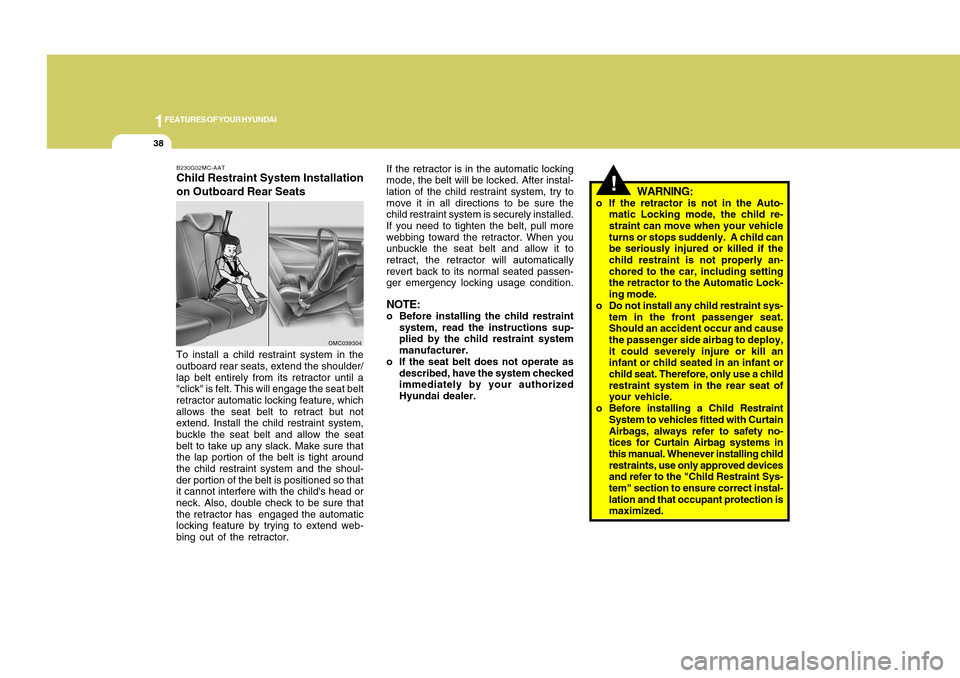
1FEATURES OF YOUR HYUNDAI38
!
WARNING:
o If the retractor is not in the Auto-
matic Locking mode, the child re-
straint can move when your vehicle
turns or stops suddenly. A child can
be seriously injured or killed if the
child restraint is not properly an-
chored to the car, including setting
the retractor to the Automatic Lock-
ing mode.
o Do not install any child restraint sys-
tem in the front passenger seat.
Should an accident occur and cause
the passenger side airbag to deploy,
it could severely injure or kill an
infant or child seated in an infant or
child seat. Therefore, only use a child
restraint system in the rear seat of
your vehicle.
o Before installing a Child Restraint
System to vehicles fitted with Curtain
Airbags, always refer to safety no-
tices for Curtain Airbag systems in
this manual. Whenever installing child
restraints, use only approved devices
and refer to the "Child Restraint Sys-
tem" section to ensure correct instal-
lation and that occupant protection is
maximized. If the retractor is in the automatic locking
mode, the belt will be locked. After instal-
lation of the child restraint system, try to
move it in all directions to be sure the
child restraint system is securely installed.
If you need to tighten the belt, pull more
webbing toward the retractor. When you
unbuckle the seat belt and allow it to
retract, the retractor will automatically
revert back to its normal seated passen-
ger emergency locking usage condition.
NOTE:o Before installing the child restraint
system, read the instructions sup-
plied by the child restraint system
manufacturer.
o If the seat belt does not operate as
described, have the system checked
immediately by your authorized
Hyundai dealer.
To install a child restraint system in the
outboard rear seats, extend the shoulder/
lap belt entirely from its retractor until a
"click" is felt. This will engage the seat belt
retractor automatic locking feature, which
allows the seat belt to retract but not
extend. Install the child restraint system,
buckle the seat belt and allow the seat
belt to take up any slack. Make sure that
the lap portion of the belt is tight around
the child restraint system and the shoul-
der portion of the belt is positioned so that
it cannot interfere with the child's head or
neck. Also, double check to be sure that
the retractor has engaged the automatic
locking feature by trying to extend web-
bing out of the retractor.B230G02MC-AATChild Restraint System Installation
on Outboard Rear Seats
OMC039304
Page 50 of 282
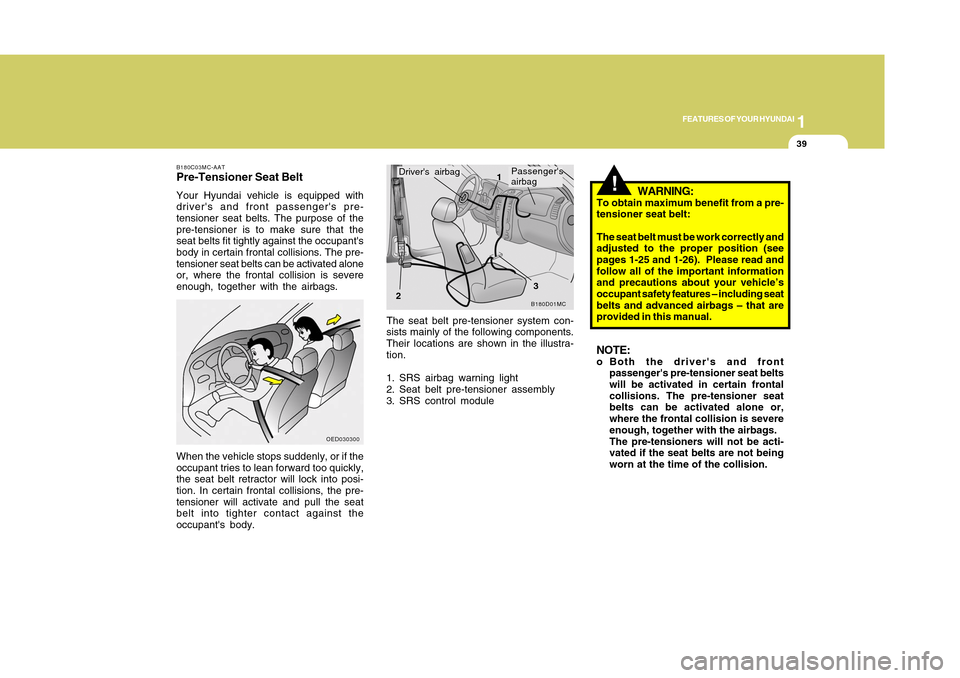
1
FEATURES OF YOUR HYUNDAI
391
FEATURES OF YOUR HYUNDAI
39
The seat belt pre-tensioner system con-
sists mainly of the following components.
Their locations are shown in the illustra-
tion.
1. SRS airbag warning light
2. Seat belt pre-tensioner assembly
3. SRS control module
When the vehicle stops suddenly, or if the
occupant tries to lean forward too quickly,
the seat belt retractor will lock into posi-
tion. In certain frontal collisions, the pre-
tensioner will activate and pull the seat
belt into tighter contact against the
occupant's body.
Passenger's
airbag
B180D01MC
Driver's airbag
1
23
NOTE:o Both the driver's and front
passenger's pre-tensioner seat belts
will be activated in certain frontal
collisions. The pre-tensioner seat
belts can be activated alone or,
where the frontal collision is severe
enough, together with the airbags.
The pre-tensioners will not be acti-
vated if the seat belts are not being
worn at the time of the collision.
!
WARNING:
To obtain maximum benefit from a pre-
tensioner seat belt:
The seat belt must be work correctly and
adjusted to the proper position (see
pages 1-25 and 1-26). Please read and
follow all of the important information
and precautions about your vehicle’s
occupant safety features – including seat
belts and advanced airbags – that are
provided in this manual.
B180C03MC-AATPre-Tensioner Seat BeltYour Hyundai vehicle is equipped with
driver's and front passenger's pre-
tensioner seat belts. The purpose of the
pre-tensioner is to make sure that the
seat belts fit tightly against the occupant's
body in certain frontal collisions. The pre-
tensioner seat belts can be activated alone
or, where the frontal collision is severe
enough, together with the airbags.
OED030300